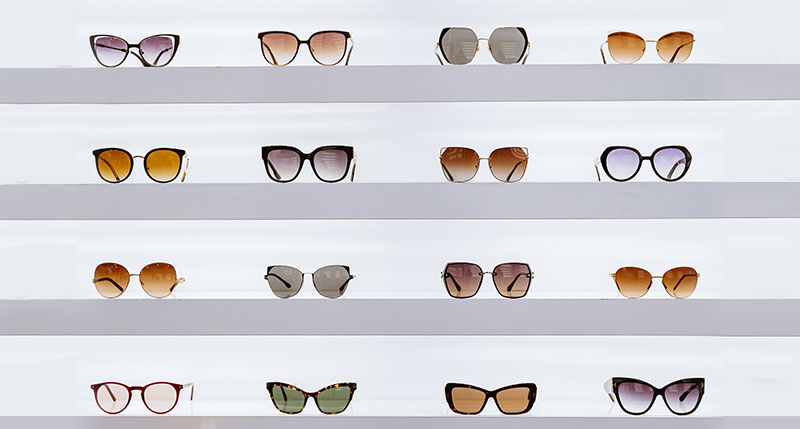If you don’t yet wear your sunglasses daily, today’s the day to start! Overexposure to the sun’s harmful ultraviolet (UV) rays over time causes eye and vision damage that can result in diseases with the potential to steal your sight. It’s a slow accumulation of damage, but one that you can avoid by wearing the proper protection of high-quality sunglasses.
If you wear prescription lenses, having a pair of prescription sunglasses is a best practice that we highly recommend. The lenses we provide will not only help you see your best in bright sun or cloudy conditions, they’ll also feature the strongest possible protection from both the sun’s UV-A and UV-B rays.
For those who don’t need prescription lenses in their sunglasses, we recommend high-quality sunglasses from our optical department that are guaranteed to protect your eyes from the sun’s damaging rays. When you purchase sunglasses from a standard retailer, they may not block 100% of harmful sunlight. In fact, only 47% of consumers check the level of UV protection offered by a pair of sunglasses before purchasing.
Here’s how to choose the best sunglasses for you. Whether you have prescription or non-RX lenses, be sure to wear your sunglasses daily!
- Consider Your Activity Level
- Sports sunglasses or sun-goggles are designed with motion in mind, offering lighter weight materials and a stronger fit for fast-paced activities, including running, biking, hiking and team sports. With grip-enhanced nose and temple pads, they’ll stay up even when you sweat. Wraparound options and interchangeable lenses are two sought-after features for sports glasses.
- Casual sunglasses. If you’re not training or competing, casual sunglasses are the right choice for everyday use whether you’re outside walking, socializing, driving, beaching or boating. They’ll protect your eyes from UV damage in style!
- Consider your Lens Choices
The lenses of your sunglasses work hard to protect your eyes and offer features that enhance your vision. A few of these include:
- This lens coating will nearly eliminate glare, that blinding aspect of light reflection off of horizontal surfaces into your eyes.
- Scratch-resistance. Be honest with yourself: Are you the type who drops your sunglasses often? If you are, scratch-resistant lenses are an ideal option for you!
- Photochromic lenses. These “smart lenses” automatically adjust to changing light conditions when you walk from a sunny outside café to the inside, or when you’re in your house and walk outside into the daylight. For people who dislike juggling two pairs of sunglasses when going from inside to outside and vice versa, photochromic lenses simplify that transition.
- Consider Your Lens Materials
- Ophthalmic-quality plastic. Plastic lenses offer great clarity and pair well with non-glare coatings and polarization. They are not as shatter-resistant as polycarbonate, though.
- With strong impact-resistance and optical clarity, this lens material is a lightweight and affordable choice.
- Acrylic is on the low-end of sunglass lens materials. Though inexpensive, it offers less optical clarity and durability than other options and may distort vision.
- Consider Your Frame Materials
- Lightweight, inexpensive and durable, many nylon frames aren’t adjustable (unless they have a wire core) but often feature high impact-resistance for active lifestyles.
- Easy to adjust for fit, metal frames—titanium, aluminum or stainless steel—can be expensive and aren’t highly durable. One downside for summer: metal frames get hot in the sun!
- Acetate (Plastic). With nearly endless color and shape options, these frames aren’t intended for high-impact sports but look great in almost every other scenario.
- Consider Your Face Shape
Now we’re getting to the crux of the matter. Your sunglasses frames do just that – frame your face, so it’s critical to choose a pair that look great.
Remember: Opposites attract. What does that mean when it comes to frame shape? In general, round sunglasses look good on a square-shaped face, and square sunglasses look good on a rounder face. Here are some good-looking choices for every face shape:
- Square-shaped face: Round, curved or oval frames.
- Round-shaped face: More angular, rectangular or squared-off frames.
- Oval-shaped face: Be sure the size of the frame is proportional to your face, but almost every frame shape will look good on an oval face.
- Heart-shaped face: To minimize a wider forehead, classic round frames (such as aviators), rimless options or butterfly-shaped styles work well.
- Oblong face: To reduce the perception of face length, oversized styles or wraparounds often work well.
When you visit our optical department, we’ll make sure that choosing your new sunglasses is an educational, positive experience. Our optical department staff is experienced in helping you pick the right frame shape, material and lenses to complement your face and lifestyle. And we even bet you’ll have fun doing so!






